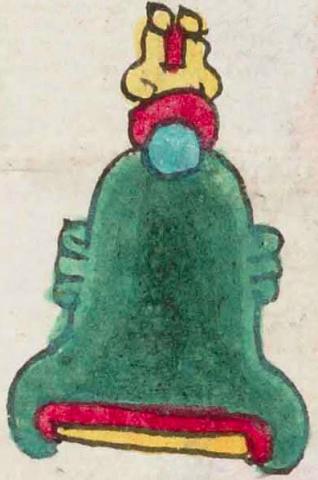Xochitepec (Mdz23r)
This compound sign for the place name Xochitepec consists of two elements for analysis. One is the flower (xochitl). It is upright, has four components, and three colors (yellow, red, and turquoise blue). The locative suffix (-c) (as given in the gloss) is not shown visually, but it combines with -tepe- to form -tepec, a visual locative suffix meaning "on the hill" or "on the mountain."
Stephanie Wood
Glyphs for flowers are often highly detailed and colorful. The attention to detail and color attest to the high value placed on flowers. The two small circles at the top of this flower, the leaves, and the roots are all hallmarks that will recur with some frequency, but, naturally, this element can also be abbreviated in some compound glyphs (e.g. the example, below, from 23 recto), and it will absorb European depictions of flowers (emphasizing stem, leaves, and largely round flowers) over time. Prior to contact, flowers appeared on temples and palaces, they were cultivated in gardens (showing horticultural expertise), they were associated with a ritualized warfare, worn as necklaces and garlands, and, for these reasons and more, they were the subject of poetry. Mexicolore has a short article about the Nahuas' fondness for flowers.
Stephanie Wood
xochitepec.puo
Xochitepec, pueblo
Stephanie Wood
c. 1541, or by 1553 at the latest
Stephanie Wood
hills, mountains, nombres de lugares

xochi(tl), flower(s), https://aztecglyphs.wired-humanities.org/content/xochitl
tepe(tl), hill or mountain, https://aztecglyphs.wired-humanities.org/content/tepetl
-tepec, on the hill or mountain, https://nahuatl.wired-humanities.org/content/tepec
Codex Mendoza, folio 23 recto, https://digital.bodleian.ox.ac.uk/objects/2fea788e-2aa2-4f08-b6d9-648c00..., image 56 of 188.
The Bodleian Libraries, University of Oxford, hold the original manuscript, the MS. Arch. Selden. A. 1. This image is published here under the UK Creative Commons, “Attribution-NonCommercial-ShareAlike 3.0 License” (CC-BY-NC-SA 3.0).


